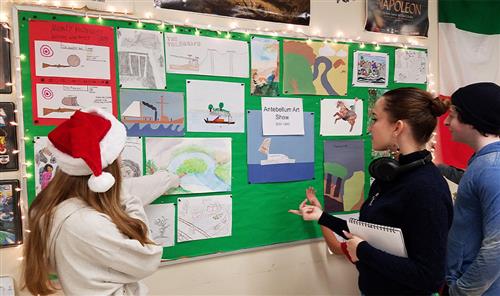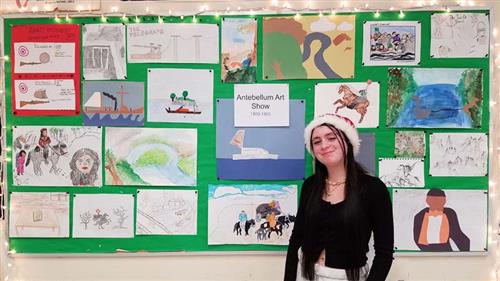Juniors Create Antebellum Art Show
Through an interdisciplinary approach, Irvington High School students expressed their knowledge of the antebellum period in the United States with art.
Having explored the history and culture of the antebellum period in teacher Dr. Erik Weiselberg’s American Studies classes, they were challenged to create, imitate or adapt a work of art or invention of the time period and write a short paragraph discussing the historical context surrounding the subject. The students chose a variety of media for their products, including paper collages, pencil, pen and ink drawings, and watercolor paintings.
“By drawing a before-and-after image of technology of the time period, this project allowed me to freely express my artistic ability while also developing my skill of discussing turning points in history,” junior Matteo Perrone said.
Dr. Weiselberg said the antebellum period was a time of tremendous change, with many inventions, such as the steamboat and telegraph, revolutionizing daily life. The students learned that New York State took on a leading role in the new nation with the completion of the Erie Canal in 1825, which several students depicted in their work. In addition, the Headless Horseman, a creation of beloved resident and village namesake Washington Irving, was a common subject of their creative pieces.
“The antebellum period also witnessed the struggles by, and violence perpetrated against, many people in America, from enslaved people of African ancestry to people of native nations forcibly dispossessed of their lands,” Dr. Weiselberg said.
Several students created depictions of the Trail of Tears, the forced removal of Cherokee and other civilized tribes from the Southeast. One student drew a picture of Harriet Tubman helping others escape slavery, and another recreated a stirring portrait of Dred Scott, an enslaved person who unsuccessfully sued for his freedom.
“It's nice to be able to apply skills from art class to the study of history,” junior Alea Gray said. “I chose a painting I remembered seeing in person, and then I had an opportunity to adapt it using my own art skills.”
In addition to Dr. Weiselberg, the students were also supported by co-teacher Trish Lyons, who provided invaluable assistance to the students with artistic choices and selection of media and materials.



